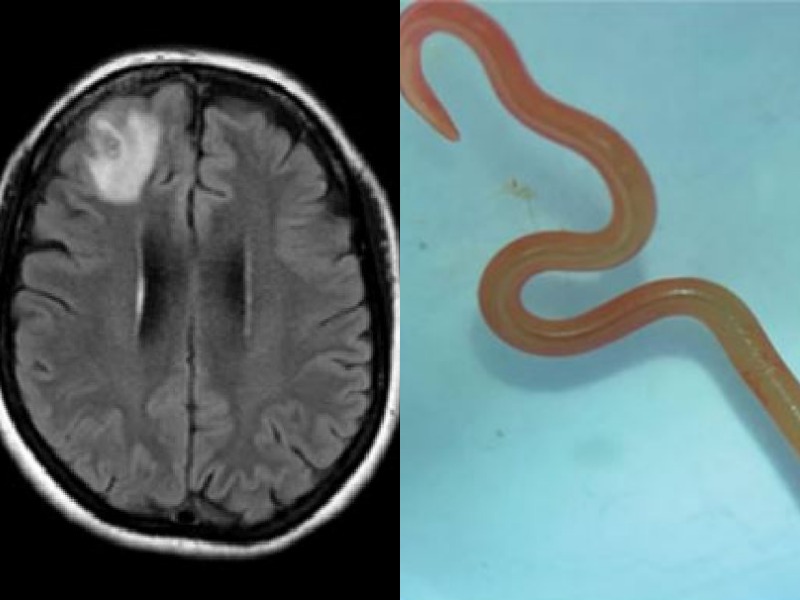Infection
‘I realised it was moving’. Roundworm pulled from patient’s brain likely came from carpet python
For a 64-year-old woman from New South Wales, what started as abdominal pain and diarrhoea, fever and night sweats, turned into a world-first, 16-month medical ordeal.
Key points:
- Surgeons removed an 8-centimetre, living roundworm from the patient’s brain followed an abnormal MRI
- The parasite is found in carpet pythons and has never been known to infect a human
- Doctors believe the infection likely came from foraged greens contaminated with python poo
Nearly a year-and-a-half after her symptoms first appeared, brain surgeons at Canberra Hospital pulled an 8-centimetre parasitic roundworm — “alive and wriggling” — from her brain.
The worm was believed to have come from the faeces of a carpet python.
It is the the first documented case of this parasite infecting a human, Australian researchers report in the journal Emerging Infectious Diseases.
The patient’s ordeal started in early 2021. Parasitic infection and a group of blood disorders called hypereosinophilic syndrome can present with similar symptoms, and so doctors treated her for both.
A CT scan in mid-2021 showed some improvement in some symptoms, but not in others.
After continued treatment and monitoring, the patient developed signs of forgetfulness and depression, prompting doctors at Canberra Hospital to perform an MRI scan in mid-2022.
The scan showed an abnormality in the right frontal lobe of the brain.
“It was important to work out what it was,” said co-author and one of the patient’s doctors Sanjaya Senanayake, of the Australian National University’s College of Health and Medicine.
“Was it part of this immune process, like cancer, or something else?”
Neurosurgeon Hari Priya Bandi, who is also co-author on the paper, said the scans didn’t show any kind of parasite that they could identify.
But follow-up scans showed the “abnormality” was changing quite quickly, which can ring alarm bells for things like tumours.
In the operating theatre, Dr Bandi said she felt something “quite abnormal” in the area where the MRI had shown a growth, which is consistent with what you’d expect from a tumour.
“But when I put in my tumour-holding forceps — basically like tweezers — I picked out a linear object.
“My immediate thought was it was some sort of wire, but then I realised it was moving.
“When I saw it was moving I was like, ‘Get it out of my hands right now!’
“We all felt some wave of nausea, and put the thing into a pot where it was rapidly wiggling and trying to escape.”
Dr Bandi said they “very excitedly called infectious disease doctors”, to find out what treatment the patient would need.
“They said at that stage all we had to do was do a really good wash out, and close up, which we did.”
Humans ‘accidental hosts’ of python roundworm
The worm was sent to the CSIRO for identification, where experts quickly identified it as a python-specific roundworm.
Loading Instagram content
Genetic analysis revealed it to be Ophidascaris robertsi — a type of roundworm common in carpet pythons and which typically infects the snakes’ oesophagus and stomach.
Eggs are passed in the faeces of the snake, which is inadvertently ingested by small mammals, which then serve as intermediary hosts.
The circle is complete when the infected mammal is eaten by a carpet python.
In their study, the researchers describe humans as “accidental hosts” and note that no human infection from any Ophidascaris species has been previously reported.
They also believe the parasite had infected other organs, including her lungs and liver.
They think the infection probably occurred when the patient ate a native ground cover, similar to spinach, which she foraged from a lake-edge near her home in south-eastern NSW.
“[The eggs are] shed in the poo of the python. We suspect that the python has contaminated vegetation that our patient has come into contact with,” Dr Senanayake said.
“We presume it’s these warrigal greens that a lot of people collect and use for cooking and salads. If the python’s pooed on that and there are eggs on that from the parasite, then it can get onto someone’s hands and they get ingested by that person accidentally.”
Though she had such a lengthy ordeal, Dr Bandi said the patient was relieved to finally have an explanation for her symptoms.
“She was very grateful for having a result because after all this time, we could say here was this thing that was causing all this trouble.”
Though this is the first known case of Ophidascaris infection, other snake parasites have been known to infect humans.
And some parasites, including tapeworms, have been extracted from human brains before.
(Note: the following video contains images of a medical procedure.)
Loading YouTube content
Wash your greens
Although this story has somewhat of a happy ending, Dr Senanayake warned that we’re seeing high rates of novel infections passed from animals to humans.
“In the past 30 years, of the 30 new infections, three quarters of them have come from the animal world and some of them have certainly had pandemic potential,” he said.
“As our environment — animal and human habitats — get closer together, people are interacting more with animals and we’re more prone to foraging, picking out beautiful flowers or warrigal greens.
He said the take home message was to be vigilant about hygiene.
“It is worth keeping in mind that there could be cross-contamination and that’s always an easy thing to do, to wash your hands after touching those things.
“And of course, if you’re going to use them as food to really clean them properly.”
Loading

